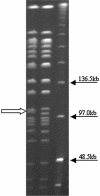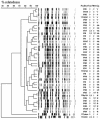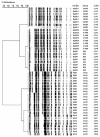Reference system for characterization of Bordetella pertussis pulsed-field gel electrophoresis profiles
- PMID: 15243034
- PMCID: PMC446263
- DOI: 10.1128/JCM.42.7.2890-2897.2004
Reference system for characterization of Bordetella pertussis pulsed-field gel electrophoresis profiles
Abstract
Pulsed-field gel electrophoresis (PFGE) has been used as an epidemiological tool for surveillance studies of Bordetella pertussis since the early 1990s. To date there is no standardized procedure for comparison of results, and therefore it has been difficult to directly compare PFGE results between laboratories. We propose a profile-based reference system for PFGE characterization of B. pertussis strain variation and to establish traceability of B. pertussis PFGE results. We initially suggest 35 Swedish reference strains as reference material for PFGE traceability. This reference material is deposited at the Culture Collection of the University of Gothenburg, Gothenburg, Sweden. Altogether, 1,810 Swedish clinical isolates from between 1970 and 2003 were studied, together with the Swedish Pw vaccine strain, six reference strains, and two U.S. isolates. Our system provides evidence that profiles obtained by using only one enzyme, i.e., XbaI, give enough data to analyze the epidemiological relationship between them. Characterization with one enzyme is far less labor intensive, yielding results in half the time than when a two-enzyme procedure is used. Also, we can see that there is a correlation between PFGE profile and pertactin type. One common PFGE profile, BpSR11 (n = 455), showed 100% prn2 and 100% Fim3 when analyzed for pertactin type and serotype. On the other hand, strains with the same profile may express various serotypes when isolated over longer periods of time. Subculturing of the same isolate eight times or lyophilization caused no change in PFGE profile.
Figures






Similar articles
-
Shifts of Bordetella pertussis variants in Sweden from 1970 to 2003, during three periods marked by different vaccination programs.J Clin Microbiol. 2005 Jun;43(6):2856-65. doi: 10.1128/JCM.43.6.2856-2865.2005. J Clin Microbiol. 2005. PMID: 15956409 Free PMC article.
-
Strain variation among Bordetella pertussis isolates in finland, where the whole-cell pertussis vaccine has been used for 50 years.J Clin Microbiol. 2005 Aug;43(8):3681-7. doi: 10.1128/JCM.43.8.3681-3687.2005. J Clin Microbiol. 2005. PMID: 16081896 Free PMC article.
-
Changes of the Swedish Bordetella pertussis population in incidence peaks during an acellular pertussis vaccine period between 1997 and 2004.APMIS. 2007 Apr;115(4):299-310. doi: 10.1111/j.1600-0463.2007.apm_556.x. APMIS. 2007. PMID: 17504296
-
Clinical outcome of pertussis in Sweden: association with pulsed-field gel electrophoresis profiles and serotype.APMIS. 2007 Jun;115(6):736-42. doi: 10.1111/j.1600-0463.2007.apm_628.x. APMIS. 2007. PMID: 17550382
-
Bordetella pertussis strains circulating in Europe in 1999 to 2004 as determined by pulsed-field gel electrophoresis.J Clin Microbiol. 2007 Oct;45(10):3257-62. doi: 10.1128/JCM.00864-07. Epub 2007 Aug 15. J Clin Microbiol. 2007. PMID: 17699646 Free PMC article.
Cited by
-
Significant gene order and expression differences in Bordetella pertussis despite limited gene content variation.J Bacteriol. 2006 Apr;188(7):2375-82. doi: 10.1128/JB.188.7.2375-2382.2006. J Bacteriol. 2006. PMID: 16547023 Free PMC article.
-
A gel-free proteomic-based method for the characterization of Bordetella pertussis clinical isolates.J Microbiol Methods. 2012 Aug;90(2):119-33. doi: 10.1016/j.mimet.2012.04.007. Epub 2012 Apr 18. J Microbiol Methods. 2012. PMID: 22537821 Free PMC article.
-
Shifts of Bordetella pertussis variants in Sweden from 1970 to 2003, during three periods marked by different vaccination programs.J Clin Microbiol. 2005 Jun;43(6):2856-65. doi: 10.1128/JCM.43.6.2856-2865.2005. J Clin Microbiol. 2005. PMID: 15956409 Free PMC article.
-
Genome diversity and evolutionary characteristics of clinical isolates of Bordetella pertussis circulating in Iran.Iran J Microbiol. 2020 Feb;12(1):1-10. Iran J Microbiol. 2020. PMID: 32322373 Free PMC article.
-
A Proteomic Characterization of Bordetella pertussis Clinical Isolates Associated with a California State Pertussis Outbreak.Int J Proteomics. 2015;2015:536537. doi: 10.1155/2015/536537. Epub 2015 May 24. Int J Proteomics. 2015. PMID: 26090226 Free PMC article.
References
-
- Ad Hoc Group for the Study of Pertussis Vaccines. 1988. Placebo-controlled trial of two acellular vaccines in Sweden: protective efficacy and adverse events. Lancet i:955-960. - PubMed
-
- Andrews, R., A. Herceg, and C. Roberts. 1997. Pertussis notifications in Australia, 1991 to 1997. Commun. Dis. Intell. 21:145-148. - PubMed
-
- Bisgard, K. M., C. D. C. Christie, S. F. Reising, G. N. Sanden, P. K. Cassiday, C. Gomersall, W. A. Wattigney, N. E. Roberts, and P. M. Strebel. 2001. Molecular epidemiology of B. pertussis by pulsed-field gel electrophoresis profile: Cincinnati, 1989-1996. J. Infect. Dis. 183:1360-1367. - PubMed
-
- Cassiday, P., G. Sanden, K. Heuvelman, F. Mooi, K. M. Bisgard, and T. Popovic. 2000. Polymorphism in B. pertussis pertactin and pertussis toxin virulence factors in the United States, 1935-1999. J. Infect. Dis. 182:1402-1408. - PubMed
Publication types
MeSH terms
LinkOut - more resources
Full Text Sources

